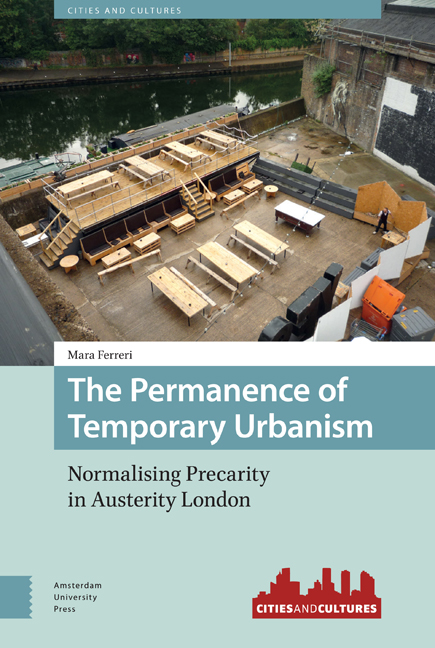Summary
Abstract
In recessional London, the celebration of pop-up art spaces plays an important part in the official narrative of temporary use as countercultural, secretive, transgressive and slightly illicit. This chapter mobilises the standpoint of visual and performative arts practitioners to analyse motivations and constraints in lawful and unlawful negotiations to access vacant spaces and their position within wider geographies of urban change. Through longitudinal case studies, it discusses tensions between community-oriented and career-oriented temporary practices and how these play out in relation to shifting cultural and urban policy. The selfreflexive experiences of practitioners reveal a critique of the ‘pop-up’ logic and the role of entrepreneurial space activators in the cracks of the creative city.
Keywords: creative city, entrepreneurship, art, performance, vacant spaces, pop-up
The experience of performers and visual artists
The relationship between art, vacant spaces and temporariness runs deep, but the 2009 recession gave rise to a real renaissance when the explosion of temporary artistic practices in empty spaces ensured the establishment of seductive cultural imaginaries of temporary urbanism. Key to this process was the glamorisation of temporary artistic uses, grounded in imaginaries of urban vacancy as secretive and exciting and the celebration of the city's creative inhabitants. In 2009, the magazine The Art Newspaper/Frieze Art Fair Daily, distributed for free at the London commercial art fair Frieze, published a full-page article titled ‘Do it yourself: pop-up galleries’ with a motivational recipe for young art practitioners wanting to start a contemporary art gallery in London: ‘You must have inexhaustible reserves of energy, a large helping of missionary zeal, and a healthy dose of chutzpah’. The string of temporary venues that emerged in this period had the attraction of being there only in the short term and were often presented as ‘secret art spaces’, as in a 2011 feature that ran in the popular weekly magazine Time Out London titled ‘Secret Galleries. Discover the best galleries you never knew existed… Visit them this weekend!’.
At the time, there was indeed a sense in the contemporary art scene that temporary spaces were becoming increasingly popular among young performers and visual artists. As commented on by a London-based visual artist in his mid-twenties: ‘it's hard to say when was the first spark… it seems everyone is doing [pop-ups] now. Access must have got easier’.
- Type
- Chapter
- Information
- The Permanence of Temporary UrbanismNormalising Precarity in Austerity London, pp. 57 - 88Publisher: Amsterdam University PressPrint publication year: 2021



